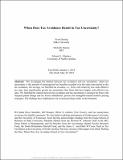| dc.contributor.author | Dyreng, Scott D | |
| dc.contributor.author | Hanlon, Michelle | |
| dc.contributor.author | Maydew, Edward L | |
| dc.date.accessioned | 2021-10-27T20:10:46Z | |
| dc.date.available | 2021-10-27T20:10:46Z | |
| dc.date.issued | 2019 | |
| dc.identifier.uri | https://hdl.handle.net/1721.1/135106 | |
| dc.description.abstract | © 2019 American Accounting Association. All rights reserved. We investigate the relation between tax avoidance and tax uncertainty, where tax uncertainty is the amount of unrecognized tax benefits recorded over the same time period as the tax avoidance. On average, we find that tax avoiders, i.e., firms with relatively low cash effective tax rates, bear significantly greater tax uncertainty than firms that have higher cash effective tax rates. We find that the relation between tax avoidance and tax uncertainty is stronger for firms with frequent patent filings and tax haven subsidiaries, proxies for intangible-related transfer pricing strategies. The findings have implications for several puzzling results in the literature. | |
| dc.language.iso | en | |
| dc.publisher | American Accounting Association | |
| dc.relation.isversionof | 10.2308/ACCR-52198 | |
| dc.rights | Creative Commons Attribution-Noncommercial-Share Alike | |
| dc.rights.uri | http://creativecommons.org/licenses/by-nc-sa/4.0/ | |
| dc.source | SSRN | |
| dc.title | When Does Tax Avoidance Result in Tax Uncertainty? | |
| dc.type | Article | |
| dc.contributor.department | Sloan School of Management | |
| dc.relation.journal | The Accounting Review | |
| dc.eprint.version | Author's final manuscript | |
| dc.type.uri | http://purl.org/eprint/type/JournalArticle | |
| eprint.status | http://purl.org/eprint/status/PeerReviewed | |
| dc.date.updated | 2021-04-09T14:31:45Z | |
| dspace.orderedauthors | Dyreng, SD; Hanlon, M; Maydew, EL | |
| dspace.date.submission | 2021-04-09T14:31:46Z | |
| mit.journal.volume | 94 | |
| mit.journal.issue | 2 | |
| mit.license | OPEN_ACCESS_POLICY | |
| mit.metadata.status | Authority Work and Publication Information Needed | |
